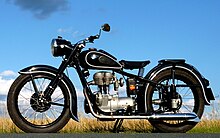BMW R 25
The BMW R 25 is a single-cylinder motorcycle model from BMW that replaced the R 24 (12 hp) model in the early 1950s , the predecessor of which, the R 23, was built from 1938 to 1940 (10 hp at 5400 rpm). The BMW R 25 also had 12 hp. According to this concept (upright single cylinder, longitudinally installed motor, cardan drive , 250 cubic centimeters displacement), BMW built several modernized models by 1965.
history
Shortly after the start of production of the R 24 in December 1948, the BMW board of directors was presented with the R 25 as a further development with rear suspension on February 16, 1949 . Series production began in May 1950; it cost 1750 DM, exactly as much as the R 24 .
BMW produced a total of 23,400 R 25s until the motorcycle was replaced by the BMW R 25/2 in October 1951 .
technology
Design features
The double tube frame is welded from tubular steel with ball heads attached to the right in the direction of travel for sidecar operation. The Steib LS 200 was an appropriate sidecar, but it required a different gear ratio for the cardan drive and a different speedometer than in solo mode. A curved dirt rag was worked into the steel sheet of the front fender. The engine block, like the gearbox and the rear axle drive, is made of cast aluminum. The silencer silencer is attached directly to the frame with sheet metal straps.
engine
The longitudinally installed single-cylinder four-stroke engine has a side camshaft and outside next to the gray cast iron cylinder in chrome-plated steel tubes running bumpers. These actuate the rocker arms in the cast aluminum cylinder head, which in turn actuate the overhead valves (OHV). Like the piston pin, the rocker arms are mounted in bronze bushings. The camshaft is driven by the crankshaft via a simple chain. The oil pump is a gear pump in the oil pan and is driven by the camshaft via a worm drive (reduction).
On the front stump of the crankshaft, behind the sheet steel cover, sit the splash-proof encapsulated direct current generator and the charge regulator for the lead-acid battery . The heavy flywheel (with the ignition timing mark - visible in the inspection hole) on the rear crankshaft stub takes the dry single-disc clutch. The clutch is operated via a thrust bearing and a push rod running through the hollow main shaft of the gear unit. The carburetor is a 22 Bing float chamber carburetor (model: 1/22/28) with a conical needle in the round slide. The wet air filter element is located directly on the carburetor. The suction filter is a steel mesh that is wetted with oil on which the dust adheres. The air filter is not changed for maintenance, but washed out in gasoline and re-wetted with oil.
drive
The drive train requires an elastic torque transmission element at the transmission output. In addition, a black rubber four-hole disc (Hardy disc) is pushed onto the two-finger flange of the gearbox on this model, which transfers the torque from the gearbox output shaft to the two-finger mount of the cardan shaft. As with the successor models, this Hardy disc is equipped with a chrome-plated steel ring all around for reasons of stability. The cardan shaft to the rear wheel is high-gloss chrome-plated and runs freely. The universal joint of the cardan shaft attached to the angular gear is covered with an aluminum screw cap against dust. A rubber seal that rotates with the shaft runs against this screw cap and keeps loose dirt out of the universal joint. The angular gear in the cast aluminum body is equipped with a bevel gear (90 ° deflection) for smoothness.
landing gear
The R 25 had half-hub brakes and 19 "steel rims (" can cover "brakes), which did not achieve the same deceleration values as the modern aluminum hubs of the successor models R 26 and R 27 with a larger braking surface.
Technical specifications
| Parameter | Data of the R 25 |
|---|---|
| drilling | 68 mm |
| Hub | 68 mm |
| Displacement | 247 cc |
| power | 12 hp (8.8 kW ) at 5600 min -1 |
| Top speed | 95 km / h |
| Empty weight | 140 kg |
| total weight | 290 kg |
| Tank capacity (ltr) | 12 L |
Web links
- BMW R 25. In: BMW History. Retrieved on May 24, 2016 (dossier from the BMW Group Archive).
Individual evidence
- ↑ Internal presentation of the first test model of the BMW R 25. In: BMW History. BMW AG, February 16, 1949, accessed on August 20, 2017 (document in the BMW Group Archive).
- ↑ Start of series production of the BMW R 25. In: BMW History. BMW AG, May 1950, accessed on August 20, 2017 (document in the BMW Group Archive).
- ↑ Price list no. 2/1950. In: BMW history. BMW AG, July 1950, accessed on August 20, 2017 (document in the BMW Group Archive).
- ↑ a b BMW R 25. In: BMW History. Retrieved on August 20, 2017 (dossier from the BMW Group Archive).
- ^ Presentation of the BMW R 68 and R 25/2 at the IFMA in Frankfurt. In: BMW history. BMW AG, October 28, 1951, accessed on August 20, 2017 (document in the BMW Group archive): "The R 25/2 is also a revision of the successful R 25."
- ↑ Handbook BMW Motorrad R 25. In: BMW History. BMW AG, June 1950, accessed on August 20, 2017 (manual with pictures, 34 pages).
